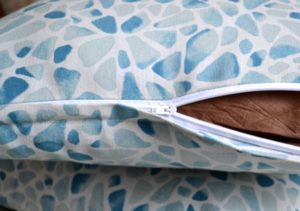A hidden zipper is a very convenient and necessary thing when making pillowcases for sofa decorative pillows. When they get dirty, they can be easily removed, washed and put on again. This is especially true in families with small children who frolic all day, jumping on the sofa or on the floor. You can decorate a duvet cover and sleeping pillows in the same way, as it is more rational than using buttons. Read on to learn how to sew a hidden zipper into a pillowcase.
How to properly position a hidden zipper in a pillowcase?
 What is the advantage of making a decorative pillow cover with your own hands? You can choose the color and texture as you wish in accordance with other decorative items. For example, very It is important to maintain harmony in the color combination of curtains, carpet and upholstered furniture. Pillows on sofas and armchairs should become a bright accent in this entire company, which will undoubtedly emphasize the taste and sense of style of the owner of the house.And choosing the right fabric for sewing textiles is very important. Buying the right zipper is also important. How not to make a mistake with this?
What is the advantage of making a decorative pillow cover with your own hands? You can choose the color and texture as you wish in accordance with other decorative items. For example, very It is important to maintain harmony in the color combination of curtains, carpet and upholstered furniture. Pillows on sofas and armchairs should become a bright accent in this entire company, which will undoubtedly emphasize the taste and sense of style of the owner of the house.And choosing the right fabric for sewing textiles is very important. Buying the right zipper is also important. How not to make a mistake with this?
Firstly, the clasp must be strongso that it does not fail during washing. Secondly, color and length must match the fabric palette and pillow size. It is necessary to decide where the lock will be located - on the end or on the side. The first method is used if there is not enough fabric for a one-piece back part or the cover has an elegant design on the front side of embroidery with threads, ribbons, beads, sequins, and lace. Or when piping, ruffles, elements of braid and decorative cords are sewn into the side seams.
What is needed to sew it on?
If you have already purchased everything you need, let's get started. Before starting the process we should prepare:
 thick fabric;
thick fabric;- cotton threads of the appropriate color;
- sewing machine;
- scissors;
- iron;
- zipper (it should be 10 cm less than the length of the pillowcase);
- tailor's chalk;
- pins;
- measuring tape.
Process steps
Important! Before you start cutting the material, It is advisable to wash on a delicate cycle, since we don’t know how it will react to the temperature and spin intensity. After this, dry and steam from the reverse side. All this is done in case the canvas shrinks. In the finished version, it may become deformed during use or maintenance. And this is very offensive, it will be a pity for the time, money and effort spent.
So:
 Use a measuring tape to take measurements on all sides of the pillow. Add 2 cm from each edge and cut into two identical squares.If you plan to wash the product frequently, it is advisable to overlay or zigzag the seams;
Use a measuring tape to take measurements on all sides of the pillow. Add 2 cm from each edge and cut into two identical squares.If you plan to wash the product frequently, it is advisable to overlay or zigzag the seams;- fold both parts facing each other, place a zipper in place of the cut along the edge, setting aside 1 cm for an allowance, and make markings with pins or chalk from the beginning to the end of the working area with teeth that will open;
- Sew the outer sections on both sides to the marked lines, retreating 1 cm from the edge of the cut. And between the markings, lay a seam with the maximum stitch without bartacks, while simultaneously loosening the tension of the thread so that it can be easily removed later;
- iron the resulting seam flat. Place the zipper on it with the wrong side up, so that the slider is at the bottom between the fabric and the braid. Secure the lock with several pins or baste with thread;
- sew the zipper, placing the line as close to the teeth as possible, not reaching approximately 3 cm from the fastening elements of the fastener. Raise the foot, leaving the needle lowered all the way, move the slider down and continue sewing. We do the same on the other side;
- we turn the fabric over and rip the thread, which sews it together in a long step at the place where the lock is fixed. Our work is finished.
Ways to secure the edges of a zipper
If for some reason the zipper is larger than required, it should be shortened. How to do this without compromising the functional properties and appearance of the lock? This can be done by reducing the length of the upper or lower parts:
 One-piece structures are shortened from below, and any structures from above. Let's look at the first option first. There are forms of fasteners - with metal teeth, spiral, tractor and hidden. Each of them can be carefully grabbed on the required segment with threads of a similar color with the teeth closed.We set aside the required length, use threads to grab this place in several stitches, and then cut it off a couple of centimeters below the applied fastening. You can move the iron bracket, securing it with pliers in this place until the excess area is trimmed;
One-piece structures are shortened from below, and any structures from above. Let's look at the first option first. There are forms of fasteners - with metal teeth, spiral, tractor and hidden. Each of them can be carefully grabbed on the required segment with threads of a similar color with the teeth closed.We set aside the required length, use threads to grab this place in several stitches, and then cut it off a couple of centimeters below the applied fastening. You can move the iron bracket, securing it with pliers in this place until the excess area is trimmed;- Shortening the top ends of an invisible zipper is also quite simple. Since it is not possible to move the plastic stoppers due to their fragility, excess centimeters are removed with scissors to the desired length. And in the place of limitation, stitches are also applied manually along the edges of the braid. If the ends are equipped with metal parts, then it is very easy to bend them and close them in this place.
But we recommend immediately purchasing a lock of the required size and suitable color, which will greatly simplify the work process. Especially if you are sewing not one, but several products.


 thick fabric;
thick fabric; Use a measuring tape to take measurements on all sides of the pillow. Add 2 cm from each edge and cut into two identical squares.If you plan to wash the product frequently, it is advisable to overlay or zigzag the seams;
Use a measuring tape to take measurements on all sides of the pillow. Add 2 cm from each edge and cut into two identical squares.If you plan to wash the product frequently, it is advisable to overlay or zigzag the seams; One-piece structures are shortened from below, and any structures from above. Let's look at the first option first. There are forms of fasteners - with metal teeth, spiral, tractor and hidden. Each of them can be carefully grabbed on the required segment with threads of a similar color with the teeth closed.We set aside the required length, use threads to grab this place in several stitches, and then cut it off a couple of centimeters below the applied fastening. You can move the iron bracket, securing it with pliers in this place until the excess area is trimmed;
One-piece structures are shortened from below, and any structures from above. Let's look at the first option first. There are forms of fasteners - with metal teeth, spiral, tractor and hidden. Each of them can be carefully grabbed on the required segment with threads of a similar color with the teeth closed.We set aside the required length, use threads to grab this place in several stitches, and then cut it off a couple of centimeters below the applied fastening. You can move the iron bracket, securing it with pliers in this place until the excess area is trimmed; 1
1





